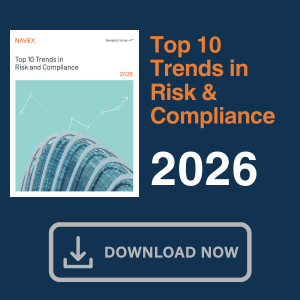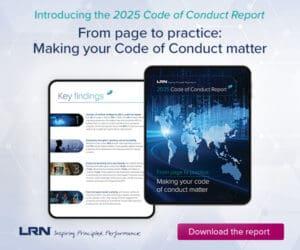What wins in the competition between urgency and caution as enterprises consider when and where to deploy AI? No single answer is right for every corporation, but Aravo’s Dean Alms says AI doesn’t change the fundamentals of good risk management — perhaps it makes them more important than ever.
AI is reshaping how businesses identify, evaluate and respond to risk. For risk management leaders, the pressure to move quickly is real. Wait too long, and your organization may fall behind. Move too fast, and you risk deploying unproven technologies without the right guardrails.
This pressure has left many risk professionals stuck between urgency and caution, or between FOMO and FOMI. FOMO is the fear of missing out on AI technology that can dramatically improve your operations and outcomes while your peers and competition are quickly moving forward. FOMI, the fear of massive implosion, comes from selecting an approach that is costly, risky and leads to failure for your company and career. These conflicting fears can lead to indecision.
But indecision isn’t the only danger. Even those taking action often fall into predictable traps that aren’t so much technical failures as they are strategic missteps. And if left uncorrected, they can derail AI initiatives before they deliver meaningful impact.
Flying Blind on AI: The New Normal for Compliance Teams
With the Senate's decisive vote against a state AI regulation moratorium, compliance officers face a stark reality: Most organizations are using AI, but not everyone has policies governing the technology as it keeps on advancing. Jennifer L. Gaskin reports on how teams are building risk-based frameworks for a world where employees love ChatGPT but can only use Copilot for work — and where AI agents may soon be booking flights and clearing transactions with questionable accountability.
Read moreDetailsAI’s evolution and pitfalls to avoid
What makes adopting AI in risk management so challenging today isn’t just how fast things are moving but how complex they’ve become. Risk leaders aren’t dealing with just one new tool; they’re juggling three.
Machine learning is quietly transforming operations behind the scenes, automating high-volume tasks like third-party screening and risk scoring, surfacing patterns no human team could detect. At the same time, generative AI is bringing a conversational layer to risk analysis, helping teams understand vendor history and threats faster and ask better questions. Looking ahead, agentic AI promises the most radical shift yet: Tools that don’t just support decisions but take action, autonomously triggering mitigation workflows or enforcing controls as risks emerge. Each of these advances is powerful on its own, but together, they’re forcing risk programs to rethink how decisions get made and where humans add the most value.
Even with the best intentions, many AI adoption efforts in risk management will go off-track, not because of the technology itself but because of flawed assumptions and misaligned strategies. Here are six common missteps risk leaders should watch out for:
1. Skipping the strategic foundation
Too often, AI efforts begin with a tool, not a strategy. Without clearly defined business objectives, governance frameworks and ethical guidelines, AI becomes a tactical experiment rather than a programmatic advantage. This lack of direction results in fragmented pilots, uneven adoption and confusion about ownership and accountability.
The fix: Tie AI initiatives to your organization’s core risk goals and governance model from the start.
2. Lack of policy on GenAI use
Assuming employees will wait for your sanctioned AI approach before using generative AI (genAI) is not wise. The availability of GenAI tools as a “freemium” puts all organizations at risk of IP leakage. When employees put enterprise content as input into GenAI for analysis, highly sensitive information can suddenly become public and available to other GenAI users outside your company.
The fix: Get a company policy in place ASAP for the use of GenAI tools. Ideally mandate a GenAI tool for all employees that will protect your IP and educate employees on the risk of using GenAI without security and privacy guardrails.
3. Underestimating the human lift
AI isn’t a plug-and-play fix; it reshapes how teams work. But too many programs under-resource change management, skipping over training, stakeholder buy-in or redesigning workflows. The result? Great tech with limited traction.
The fix: Treat AI as a change initiative, not just a tech rollout. Engage people, not just platforms.
4. Failing to match AI to risk maturity
An AI roadmap built for a digitally mature global enterprise won’t work for a mid-market company still using spreadsheets. Yet many risk teams adopt generic frameworks without evaluating their own program maturity, data quality or operational readiness.
The fix: Assess your current capabilities and build an adoption plan that fits your unique maturity level and appetite for risk.
5. Misreading your position on the innovation curve
Where you sit on the innovation curve — visionary, early adopter, pragmatist or skeptic — shapes how you should approach AI. Misjudging that position leads to either rushing into deployments that outpace your infrastructure or hesitating so long that the organization loses competitive ground.
The fix: Align your AI ambitions with where your organization truly is, not where you wish it were. This clarity is also essential for getting executive buy-in.
6. Waiting for perfect readiness
Some organizations get stuck in AI paralysis, believing they need perfect data or full system integration before making a move. But perfection is a moving target, and waiting often means missing out on early value and momentum.
The fix: Start small, learn fast and iterate. AI can help you close gaps, not just act once they’re resolved.
From missteps to momentum
AI may be accelerating how we detect and respond to threats, but it doesn’t eliminate the fundamentals of good risk management — sound governance, informed oversight and strong collaboration. If anything, it raises the bar.
As regulators evolve their expectations and stakeholders demand more resilience, the risks of falling behind are no longer hypothetical; they’re operational, reputational and strategic. The organizations that succeed won’t be those that rushed in or held back. They’ll be the ones that moved with clarity, intention and a plan tailored to their unique risk environment.




 Dean Alms is the chief product officer for
Dean Alms is the chief product officer for






